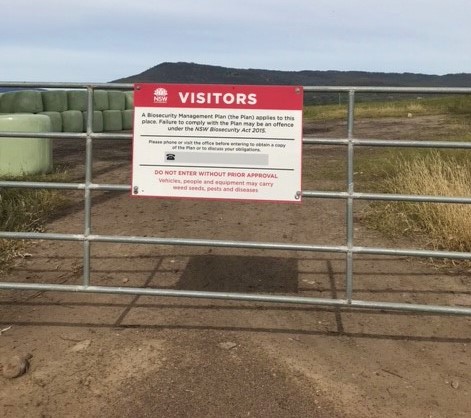Farm biosecurity - do you know your risks?
05 Aug 2022
PRODUCTION ADVICE & NRM NEWS - AUGUST 2022 - AGRICULTURE & AGRONOMY
By Adrian Smith, Senior Land Services Officer - Mixed Farming Systems
P: 03 5881 9932 | M: 0447 778 515 | E: adrian.smith@lls.nsw.gov.au
With Foot and Mouth Disease ravaging parts of Indonesia, biosecurity is the word on every farmer’s lips at the moment. So, what can we do to protect the Murray region?
Luckily, biosecurity doesn’t have to be hard, and a simple, tailored biosecurity plan can help protect your farm business.
Preventing the introduction of animal and plant diseases and weeds by sticking to some simple rules may prevent disaster. As primary producers or visitors to a farm, we all have a role in ensuring we are aware of the risks, implications and ways to manage farm biosecurity.
Good biosecurity is simply a series of basic management practices to prevent or minimise the risk of introducing contagious diseases and noxious weeds.
Preparing a Farm Biosecurity Plan
A biosecurity action plan will help you identify and prioritise implementing biosecurity practices relevant to your property and business.
When preparing your on farm biosecurity plan, the essentials are a good place to start. These include:
- Farm inputs and outputs – such as feeds (particularly purchased), animals and seed, fertilisers, chemicals, water supplies and drainage waters
- People, vehicles and equipment – including appropriate signage, vehicle and equipment hygiene, movement of people to and from your farm
- Production practices – such as the use of irrigation and drainage waters, fences (good fences make for good neighbours!), vaccination and drenching programs, chemical applications, crop and animal health monitoring
- Ferals and weeds – wild and feral animals can mix with your own stock, spread disease, and contaminate feed and water. Weeds in their own right can pose significant biosecurity risks.
- Train, plan and record – have good systems in place, record stock movements, and have staff and family members well-trained so they know what to look out for, be vigilant and report anything suspicious.
Completing a self-assessment checklist will also help you identify your property's biosecurity strengths and weaknesses. It might be helpful to have a map of your property to consider the best places to locate biosecurity zones or ‘checkpoints'. This could include signs at entrances to the property, parking areas near the house or site office, where deliveries are picked up or dropped off in relation to storage facilities, vehicle wash-down areas, and existing roads or tracks for movement within the property.
Think about how you can minimise the risk of introducing diseases, pests and weed seeds at each checkpoint. Biosecurity should become a habit if you build your plan around daily, monthly or yearly farm routines.
The actual management practices you choose to use will vary from site to site, depending on the size of your property(s), the physical facilities available, climate and the day-to-day management of your operations.

Where can I get some more advice?
Many farm organisations and industry bodies have developed their own biosecurity plans and templates.
Simple things like having signage at your farm entrances will ensure biosecurity is kept ‘front of mind’ to any visitor or farm worker.
An excellent resource is the ‘Farm biosecurity’ website. Producers can access a range of advice and toolkits to help prepare their own biosecurity plan.
Local Land Services biosecurity and veterinary staff can provide a wealth of knowledge to assist you in preparing for and managing a biosecurity threat. Your consultants and practitioners will also be valuable sources of advice to help you identify potential risks and strategies to mitigate those risks.
No matter what you do, biosecurity is everyone’s responsibility. The threats to your individual farm business, not to mention Australia’s economic and social prosperity, are real but manageable. Remember to check your property(s) regularly and, if you see or suspect anything unusual, call the Emergency Animal Disease Watch Hotline on 1800 675 888 or the Exotic Plant Pest Hotline on 1800 084 881.
Remaining vigilant, understanding your risks and implementing good hygiene practices on your farm are relatively simple but highly effective strategies to help minimise the outbreak of a biosecurity threat on your farm.